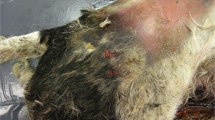Abstract
The authors report on a young boy who was bitten into his face by an unknown animal while being asleep in a tent. Given the bite marks and the location of the scene, members of the mustelidae and canidae families were the first “suspects.” Deoxyribunucleic acid (DNA) recovered from the tent’s wall was analyzed with regard to parts of the mitochondrial 12S ribosomal ribunucleic acid (12S rRNA) and cytochrome b (cytb) genes as well as nuclear short tandem repeats (STRs). Since Sanger sequencing revealed a mixed sequence with a strong human component overlying the nonhuman contributor, an animal screening using a duplex real-time polymerase chain reaction (PCR) with an intercalating dye and melt curve analysis was employed. The results were later confirmed by cloning. The applied commercial canine STR kit verified the animal family (canidae) but did not help in discriminating the species due to cross-species amplification. In the presented case, the real-time PCR assay offered the cheapest and fastest method for animal family determination, which then allowed for an appropriate and sample-saving strategy to characterize the causative animal species.




Similar content being viewed by others
References
Linacre A, Tobe SS (2011) An overview to the investigative approach to species testing in wildlife forensic science. Investig Genet 2:2. doi:10.1086/2041-2223-2-2
Parson W, Pegoraro K, Niederstätter H, Föger M, Steinlechner M (2000) Species identification by means of the cytochrome b gene. Int J Legal Med 114:23–28. doi:10.1007/s004140000134
Sato I, Nakasi S, Murata K, Takeshita H, Mukai T (2010) Forensic hair analysis to identify animal species on a case of pet animal abuse. Int J Legal Med 124:249–256. doi:10.1007/s00414-009-0383-2
Melton T, Holland C (2007) Routine forensic use of the mitochondrial 12S ribosomal RNA gene for species identification. J Forensic Sci 52:1305–1307. doi:10.1111/j.1556-4029.2007.00553.x
Balitzki-Korte B, Anslinger K, Bartsch C, Rolf B (2005) Species identification by means of pyrosequencing the mitochondrial 12S rRNA. Int J Legal Med 119:291–294. doi:10.1007/s00414-005-0537-9
Tobe SS, Linacre AM (2008) A technique for the quantification of human and non-human mammalian mitochondrial DNA copy number in forensic and other mixtures. Forensic Sci Int Genet 2:249–256. doi:10/1016/j.fsigen.2008.03.002
Tobe SS, Linacre A (2010) DNA typing in wildlife crime: recent developments in species identification. Forensic Sci Med Pathol 6:195–206. doi:10.1007/s12024-010-9168-7
Karlsson AO, Holmlund G (2007) Identification of mammal species using species-specific DNA pyrosequencing. Forensic Sci Int 173:16–20. doi:10.1016/j.forsciint.2007.01.019
Berger C, Berger B, Parson W (2009) Canine DNA profiling in forensic casework: the tail wagging the dog. Forensic Sci Rev 21:1. doi:10.1007/s12024-009-9114-8
Linacre A, Gusmão L, Hecht W, Hellmann AP, Mayr WR, Parson W, Prinz M, Schneider PM, Morling N (2011) ISFG: recommendations regarding the use of non-human (animal) DNA in forensic genetic investigations. Forensic Sci Int Genet 5:501–505. doi:10.1016/j.fsigen.2010.10.017
Eichmann C, Berger B, Reinhold M, Lutz M, Parson W (2004) Canine-specific STR typing of saliva traces on dog bite wounds. Int J Legal Med 118:337–342. doi:10.1007/s00414-004-0479-7
Acknowledgments
This work is part of a study on animal family screening granted by the Deutsche Forschungsgemeinschaft (SCHM2471/1-1). We wish to thank the project group on species determination for their support.
Author information
Authors and Affiliations
Corresponding author
Rights and permissions
About this article
Cite this article
Naue, J., Lutz-Bonengel, S., Pietsch, K. et al. Bite through the tent. Int J Legal Med 126, 483–488 (2012). https://doi.org/10.1007/s00414-012-0674-x
Received:
Accepted:
Published:
Issue Date:
DOI: https://doi.org/10.1007/s00414-012-0674-x




